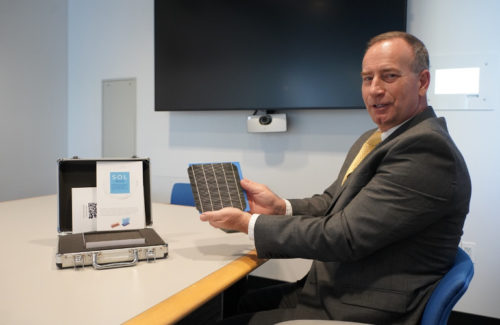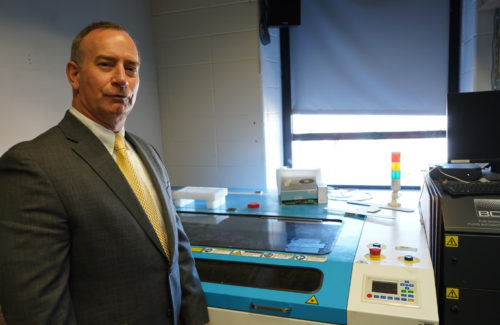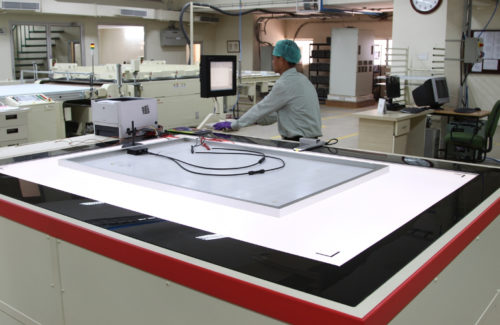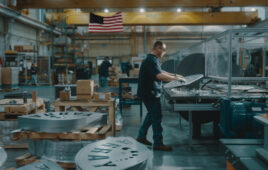The solar panel manufacturing and assembly market in the United States is on the rise right now. Established names like LG, JinkoSolar and Hanwha Q CELLS all plan to have U.S. facilities pumping out new panels in 2019. And despite those big names with megawatt-capacities in the hundreds setting up in the United States, smaller companies still think there’s room for them in a Made-in-the-USA market.
SolSuntech is planning a 100-MW facility in Virginia with a brand-new crystalline silicon process. GreenBrillance will build a 125-MW facility in Maryland to manufacture premium panels at an average price. Both companies’ unique business plans just might make a big enough impact to outshine the big-named competition.
SolSuntech’s new silicon solar cell design
SolSuntech is a new American solar company with a Korean history. Chairman Jang Hi-Chul and a team of engineers have spent over a decade and $7 million perfecting a new type of technology in South Korea that will disrupt the solar panel market. The company was officially incorporated in Delaware earlier this year, and the U.S. market will be the first launchpad for the SolSuntech three-dimensional solar panel.
“Every panel manufacturer out there makes a flat-surface cell,” said Lou Kraft, CEO of SolSuntech. “The difference is that this one is a 3D-corrugated-like wave cell.”
SolSuntech’s design is a corrugated silicon cell that will reabsorb sunlight that is normally reflected off a traditional, smooth-surface “2D” cell. The company’s proprietary technology uses high-precision mechanical cutting tools to slice the silicon wafer into a 3D, curved shape. SolSuntech expects its monocrystalline solar panels to reach 600 W and have a 33% efficiency—in the same 72-cell footprint as a normal panel reaching 370 W and 21% efficiency on the highest end.
The SolSuntech solar panel does not yet exist, but Kraft said the engineers’ protypes have been third-party tested and the company is confident in its wattage and efficiency claims. SolSuntech expects panel availability by December 2019.
“It’s independently tested, and once a prototype exists, we’ll have it UL certified,” Kraft said. “We’ll have one of the best warranties with it, since we’re going to have to go up against the big competition out there. They’re not going to like us, as the little guy on the block touting a 33% [efficiency]. They’re going to attack us from all angles, so we’re ready for that.”
SolSuntech is currently in the funding phase and has an ICO and IPO set up through the end of the year.
“We feel it’s a good way for us to get in,” Kraft said. “It’ll also level the playing field for the average investor out there. The little guy can get in instead of just the institutional factors making all the money.”
Right now, SolSuntech has its sights set on a 300,000-sq. ft former furniture assembly warehouse in Virginia for its manufacturing headquarters. The state has offered significant incentives for the company to set up shop there. SolSuntech plans to start with 100 MW of production the first year, but with the significance of the panel’s technology, Kraft said there has to be room to grow in capacity. The Virginia facility could maybe expand to 300 MW, so the company has been exploring other turnkey operations in the United States, including Suniva’s abandoned plants in Michigan and Georgia.
The SolSuntech product will be uniquely American—from cell to final panel. Because the company has a specific cell design that must be cut by its own equipment, wafers will be turned into cells in the United States.
“We will bring in actual ingot material into Virginia,” Kraft said. “We will bring in wafers and cut them ourselves. We’ve already invented four of the machines for cutting the cell. The rest of the assembly process [will be in the United States] too.”
SolSuntech will target the residential and small commercial markets since they’re looking for the best efficiency and most generation in a fixed space. The company plans to keep its manufacturing process close to heart, but with such a game-changing technology, SolSuntech could potentially be starting a new panel category, like PERC and half-cells, that could be expanded to more manufacturers.
“You’ve got typical panels out there, and then you’ve got Tier 1 which are about 21 to 22% efficient now. We’re looking to compete with Tier 1—33% efficiency at Tier 1 pricing,” Kraft said. “Moving forward, if it creates its own Tier or this design becomes adopted since we’re able to cut this wafer, stabilize it from fractures and get a good product out of it…it’s very possible. [First] I want to get manufacturing it ourselves going. I want to see what market we command with it, how many facilities we’ll need and what our output will be.”
GreenBrilliance wants to be an affordable and friendly option
GreenBrilliance has been a residential and mid-sized commercial EPC in Virginia since 2007. President and CEO Sumit Bhatnagar also established panel manufacturing overseas in India around the same time, selling panels in India, Europe and the United States. When the Indian solar market really started to take off, GreenBrilliance couldn’t meet domestic demand and also supply other markets. The last containers of GreenBrilliance panels were brought to the United States around 2014, and then the company made panels in India exclusively for Indian installations. Now Bhatnagar is ready to set up a domestic manufacturing facility in Baltimore, Maryland.
“I started to figure out what it would take to manufacture here,” Bhatnagar said. “We have experience of making panels, we have the supply chain, we know what to buy, we know how to manage the whole set-up.”
Bhatnagar kept hearing again and again that solar manufacturing could not happen in America. He thinks that’s because U.S.-based panel manufacturers are charging too much for their product.
“I can buy the same panels in Dubai for 50 cents/watt. The moment we talk about bringing those panels to America, it’s $1/watt,” he said. “We’re paying $1 for the same product that someone in [Asia] can get for 50 cents. We’re not putting gold plating on the panel just for America.”
GreenBrilliance plans to make premium solar panels—monocrystalline, PERC, bifacial—at affordable prices in the United States.
“If you have to buy a bifacial panel in America, you have to pay a premium, and I don’t understand why. It cannot cost a manufacturer almost 100% more to make a bifacial panel,” he said. “They’re trying to extract as much premium out of bifacial because it’s being sold as a specialized product. I don’t want to have a specialized product—it’s just a monocrystalline panel.”
Bhatnagar believes that instead of panel buyers just trusting a Tier 1 label as the best product worthy of a higher price tag, they should consider visiting smaller manufacturers to see the quality of materials being used and see if they’re really “inferior.”
“People only want to buy Tier 1 panels just because it’s a big factory,” he said. “We want to build something that we say it is. It’s Made in America. We don’t want to be a gigawatt factory today. We want to be a true factory.”
GreenBrilliance’s local experience as a solar installer has offered it the chance to use many panel brands. Bhatnagar said he’s proud that GreenBrilliance has not installed one Chinese panel in the company’s 11 years of business—Tier 1 or not. He feels there is still a need for high-quality American-made solar panels, and GreenBrilliance can meet that demand.
“Tier 1 warranties still fail. If you really want a quality panel, come and see it. Don’t trust the Tier 1. Everyone is welcome to come see our factory and our process,” he said. “As long as you use the right materials, if the panels are made with raw materials that are correct, your panels will be top quality and they will last.”
The plan is for GreenBrilliance panels to begin shipping out of its 125-MW Baltimore facility in Summer 2019. Although many of the larger Tier 1 brands entering the United States will have a head start with product available before GreenBrilliance, Bhatnagar said he will market his company as the cheaper, more accessible panel manufacturer. Not only will GreenBrilliance’s premium panels not be sold at a premium price, but the company will be available to answer any questions.
“We’re not just bringing the price aspect. We’re bringing quality and the warmth of business,” he said. “We will talk to you. We will work with you. We’d be happy to provide engineering help. We are trying to address the American installers who are struggling. We’re not going after a SolarCity or Sunrun. Our customers are the 5,000 installers in the middle of nowhere trying to find supply and install panels. They need help, but no one is reaching out to them.”
Bhatnagar said if more companies focus on what they’re buying rather than who they’re buying, his small manufacturing business will do just fine.
“The focus on what you’re buying is gone. Now it’s who you’re buying,” he said. “Vet what you’re buying. Trust your eyes and then buy.”








I would like to get in contact with both SolSunTech and GreenBrilliance. Do you have phone numbers or email addresses that you could provide me? I wish to see if we can add value to their supply chains, assisting them with their transportation & logistics operations. Thank you.
Sorry, we don’t give out source contact information, but I will send them a message that you’re looking to reach out.
Hopefully these companies can deliver on thier goals.
I look forward to innovation in renewable energy and companies that push the edges of the envelope out further.
I especially applaud the “new mousetrap” of the 3-d solar cell. We’ll need American innovation to get solar module efficiency up sufficiently to cover the declining tax credit. Go American manufacturing and innovation!